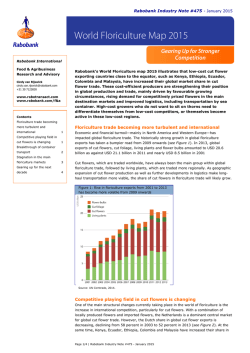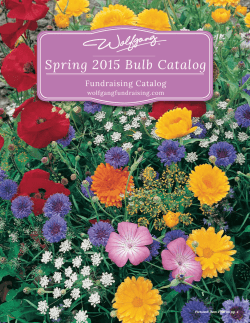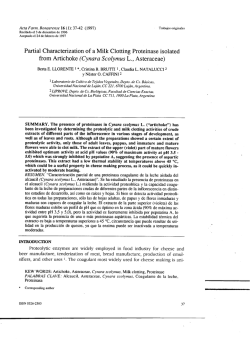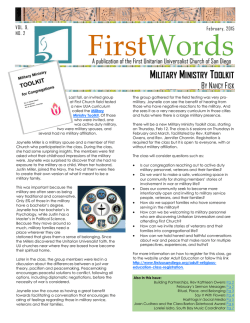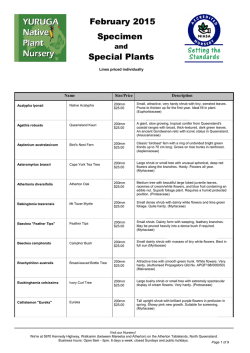
Haiti : Perspectives on Cut Flower Production1
Haiti : Perspectives on Cut Flower Production1 Richard Féthière Abstract: Flowers have been grown and produced commercially in Haiti for a long time. Prior to the 1970’s flowers were grown around the main family house as a way for the women of the house to supplement the family income. In the 1980’s a multitude of florists opened their doors and business was brisk. The florists purchased flowers on the local market but relied mainly on imported flowers to satisfy the demand. Local flower production remained small and unreliable and most local enterprises were amateur in nature except for a few producers who applied advanced production techniques and were able to export quality flowers on a regular basis. Flower is a huge business worldwide. Haiti has a variety of ecosystems where all kind of flowers can be grown with the right expertise. Socio-economically speaking, the flower business is an opportunity for women to enter the economy and own a business providing that social economic organizations are reinforced, and that the State of Haiti and the State University System provide the framework, the training and the agricultural support system and the agricultural credit necessary for its development in a sustainable and beneficial way for the economy. Rezime : Pandan lontan yo toujou fè flè pouse an Ayiti pou yo vann. Anvan ane 1970-yo, yo te konn flè pouse alantou kay lafanmi an. Se te yon fason pou medam yo, ki ap viv nan kay la, fè yon ti kòb an plis Nan ane 1980-yo gen yon dal fleris ki te louvri magazen flè epi sa te mache byen pou yo. Fleris yo te achte flè yo vann yo nan peyi a, men yo konn kòmande flè nan peyi etranje pou yo pa pran pàn nan lavant yo. Fè flè pouse nan peyi a pou lavant pa te yon gwo biznis. Moun pa te fouti depann sou sa pou yo viv, epitou pwodiksyon flè nan peyi a se te ti biznis pou moun ki pa gen anpil eksperyans, aleksepsyon kèk grenn pwodiktè flè ki te sèvi ak teknik avanse epi yo te rive ekspòte bon kalite flè regilyèman. Komès flè se yon gwo biznis patou sou latè. Ayiti gen divès kalite ekosistèm, kote tout kalite flè ka pouse si genyen bon ekspètiz. 1. INTRODUCTION F lowers have been grown, produced, and harvested in Haiti for as long as one can remember. Prior to the 1970s flowers were grown around the main family house as a way for the women of the house to supplement their income. I can still remember producers coming to our house on Saturdays to bring roses, anthuriums, gladiolus and calla lilies in buckets full of water. Roses were produced at the Ministry of Agriculture, located in Damien (a northern suburb of Port-au-Prince, the capital of Haiti). Today, the flower business is still alive and well, at least in the Port-au-Prince metropolitan area. Flower traders now occupy several street corners and sidewalks in Pétion-Ville, another suburb of Port-au-Prince, and along the Panaméricaine Street and Kenscoff Road. Their main selling center has now been officially consolidated on the North side of St Pierre Square in Pétion-Ville where all kinds of flowers and arrangements can be purchased by passers-by and local florists alike. The author has estimated that the flower market in Pétion-Ville alone can be valued at US $1.5 million dollars annually based on interviews conducted between 2010 and 2014 as part of the University of Florida-Gainesville collaborative work with the WINNER Project [1]. The 1970s and 1980s saw a many florists open their doors to satisfy the demand for flowers on the local market. In 2010 the author has inventoried no less 1. This paper was recently the topic of an opinion editorial in the NY times. http://www.nytimes.com/2014/12/25/opinion/nicholas-kristofscrooges-of-the-world-begone.html?rref=collection%2Fcolumn%2 Fnicholas-kristof&contentCollection=opinion&action=click& module=NextInCollection®ion=Footer&pgtype=article&_r=0 36 than forty-two (42) florists in the Port-au-Prince Metropolitan area (including Delmas and Pétion-Ville) [2]. That flower market has thrived until it was severely disturbed by 1) an unstable political environment in the late 1980s and 1990s and 2) the 2010 earthquake. To quote one producer in Furcy talking about the flower business after the tragic event : “Se yon biznis kè kontan !” which translates literally to mean that flowers is the “business of happy hearts”, that is, the industry thrives most when people are happy. Flowers are a reality in Haiti and satisfy many needs. They provide additional income with which producers can acquire what they need for their families. Flowers are used on a daily basis for a variety of occasions : weddings, funerals, first communions, receptions, well-wishers to hospitals, requests to different catholic saints or even sometimes as offerings for “lwas” (spirits served in Vodou religion) [3, 4], Fête-Dieu processions, and every year at Carnaval flowers are seen on floats and as accessories for the queens. The Haitian culture uses more flowers than it produces as evidenced by the healthy import market that thrives to supply the local vendors ; flowers that could be produced locally, thus contributing to job creation. Even the plastic flower market seeks to take advantage of this existing demand. However, these are all imported, and are associated with plastic pollution. Indeed, the plastic material is not biodegradable and end up in the garbage stream and the environment. The local market for natural flowers is alive and well in Haiti. It has created jobs for years, and deserves to be supported through education of farmers, agricultural extension, and agricultural credit financing. Haïti Perspectives, vol. 3 • no 3 • Automne 2014 Cahier thématique – Économie sociale et solidaire 2. THE GLOBAL FLOWER MARKET : AN OPPORTUNITY FOR HAITIAN INVESTORS Cut flowers are produced commercially in approximately 80 countries around the world. Flowers are sold and distributed everywhere on the globe, including Haiti. The global flower market totals US$ 40 billion annually. The Netherlands supplies 54 % of that market followed by Colombia 16 % (US$ 6.4 billion), Equator and Kenya with 6 % (US$ 2.4 billion) each. All of the other 76 countries combined produce 18 % of all the flowers sold on the world market. There is a lot of money to be made in the flower business, and Haiti can be one of the successful producers [5, 6]. The five biggest importers of flowers in the world are Germany, USA, the Netherlands, Italy and Japan. In the U.S. alone, $14 Billion worth of cut flowers are sold annually of which 82 % are imported. Haiti can be one of the closest flower suppliers of the U.S. outside of Mexico and Canada. Haiti also has commercial exchanges with the other four biggest buyers of flowers in the world. It is possible to develop a flower relationship with these countries in the future with the right approach. Carnations, Ginger Lilies and Birds of Paradise. Smaller producers of cut flowers around Pétion-Ville, Fermathe, Kenscoff and Furcy have specialized in the production of different species. Their flower production was always mixed with other cultures (corn, beans, tomatoes next to chrysanthemums, gladioli and baby’s breath), allowing them to generate some income while they waited for their staple crops to reach maturity. For a long time, carnations were also produced in the watershed by small to medium producers mainly around the house. Some producers around the area of Atis near Fermathe specialized in gladiolus, Baby’s Breath and Snapdragons (Gueule-de-Loup) (Fig. 2) while others around Kenscoff and Furcy made chrysanthemums and Lilies their specialty. 3. LOCAL FLOWER GROWER To my knowledge, there is no statistics of flower production in Haiti. An export flower production has thrived for many years in and around Port-au-Prince. One of the producers is Golden Orchids (GO), who has produced Cattleyas (Fig. 1) for over thirty years for both the local and the international markets [7]. This enterprise has been recognized as one of the main producers of this variety of orchids in the world exporting up to 1,500 flowers per week at its peak (picture below). Figure 2 Snapdragons in the area of Atis These smaller producers benefited from a strong collaboration with the Baptist Mission located in Fermathe which provided both seed and plant materials as well as a place where the flowers could be sold to eventual customers and tourists visiting the Center, the Mission and the Hospital. These farmers still exist and have proven that when supported, they can deliver a quality product to market. 4. WHEN TO GROW ? Figure 1 The Cattleyas orchid in the Golden orchids green house Anthurium is another flower species that has been produced and exported from Haiti for many decades. During the 1980s there were also various attempts at growing Chrysanthemums, A production cut flower calendar destined for farmers and potential investors in the flower sector in Haiti was developed by the author (Table 1). This production calendar including periods of peak flower sales is designed to help producers make accurate decisions on planting dates, seeding dates, harvest dates and color of cultivars to be planted. Cultivars are plants selected for desirable characteristics that can be maintained through vegetative reproduction. This tool can allow producers and investors to anticipate demand and ready their products for market at the exact time they are needed. The business of flowers is a business that can provide an income opportunity yearlong if one knows what to plant and when to harvest it. Haïti Perspectives, vol. 3 • no 3 • Automne 2014 37 Cahier thématique – Économie sociale et solidaire Table 1 Cut Flower Production Calendar for Haiti – Peak Sales Dates [2] DATE EVENT FLOWERS COLORS Notre Dame d’Altagrace Anthurium, Pompon and Lilly Blue and White Valentine Day Rose, carnation, Lilly Red and White March-April Easter Lilly White May – June First Communion Calla White May Mother’s Day USA (Export) 2nd Sunday in May Various species high return Red and white May Mother’s Day Haiti Last Sunday in May Various species Red and white June 27 Notre Dame du Perpétuel Secours Pompon All colors June 11 Fête du Sacré-Coeur Anthurium – Carnation Red and White June 29 Fête St. Pierre November 1 Day of the Dead December 25 Christmas Various species Red Yearlong –Peak 1 June-August Weddings Chrysanthemums, lilies, snapdragons, gladiolus, heliconia, statice, gypsophila All colors Yearlong – Peak 2 Dec-Jan Weddings Chrysanthemums, lilies, snapdragons, gladiolus, heliconia, statice, gypsophila All colors Yearlong Funerals Chrysanthemums White,Yellow,Purple Yearlong Florists Various species All colors Yearlong Street corner flower stand Various species All colors January 21 Feb 14 5. WHAT TO GROW ? There is an increase in the demand for cut flowers both locally and on the international market [8, 9, 10]. There is always a major demand for new varieties and new species of flowers. Changes in consumer demand, crops grown and methods of culture create an ever existing opportunity. The insatiable desire for new varieties and increased world competition are some of the driving forces behind this increase in flower consumption. These new trends in the flower market can be witnessed at major international flower trade shows where breeders, growers and marketers exhibit their products and court new potential buyers. According to Armitage and Laushman [8], “specialty cut flowers” have become the most important part of the U.S. cut flower industry. “The combined production of carnations, chrysanthemums and roses was $78 million in 2002, representing 15 percent of total cut flower production”. In opposition, the remaining specialty cut flower production totaled $443 million [9, 10]. 38 Cut Lilies have replaced roses as the most important domestically produced flower. Gerberas, gladiolus and tulips are in the top five specialty cuts and they all, except the tulips, have been tried and grow well in Haiti. Other flowers that can be grown in Haiti are orchids, miniature orchids, hydrangeas (hortensias), miniature tropical flowers and mini gladiolus. Garden flowers are the new rage for cut flowers and wedding bouquets and include Queen Ann’s lace, Curcuma, Feverfew and Campanula among others. During the last four years I have conducted many trials with other University of Florida researchers in parts of the Culde-Sac watershed – area drained by Rivière Blanche and Rivière Grise[11]. Trials were held specifically at Bas-Boen (75 m in altitude), Duvier (700 m) and Kenscoff (1,500 m). These trials, the purpose of which was to assess how suitable the cultivation of new flower species would be in Haiti’s climate, evaluated new cultivars of chrysanthemums (12), gladiolus (12), alstromerias (4), roses (5), snapdragons/gueule-de-loup (8), statice (6), Haïti Perspectives, vol. 3 • no 3 • Automne 2014 Cahier thématique – Économie sociale et solidaire anthruriums (10), gingers lilies (5), baby’s breath/nuage des fleuristes (2), oriental and asiatic lilies and gerberas. Some local tropical flowers like Hydrangeas, Heliconias, Sunflowers and Birds of Paradise were also evaluated. The great majority of these species has blossomed in parts of the watershed that satisfied their requirements for light and temperature. Such a result points to an opportunity for growers who already produce flowers in the watershed where other exotic species grow wild and unattended. The opportunity exists to further develop cut flower production and take advantage of the above described conditions of the global market. 6. WHERE TO GROW THE SELECTED SPECIES ? Flowers come well everywhere in the watershed surrounding Port-au-Prince. Furcy, Kenscoff and Fort-Jacques are well known production centers. Yet, these areas are not the only ones suitable for flower production in Haiti. With about 75 % of the surface of Haiti covered by land going from sea level to close to 3,000 meters, there is in Haiti a multitude of micro-climates where a variety of species – like the ones mentioned earlier – feel right at home and can thrive when temperatures are between 10 oC and 24 oC. 7. HOW TO GROW SELECTED SPECIES ? Market conditions require a standard product that is free of major defects and diseases like the chrysanthemums and gladioli produced under greenhouse in Furcy (Fig. 3). Flowers must also be ready at a specific date during the year. In order to satisfy these requirements, a drastic improvement in cultural practices is necessary. In some situations, precision irrigation or drip irrigation must be available year long, and plants must be protected from the environment so they are not damaged by heavy rains, hail, high winds or too much sun. Some species are also light sensitive and may require an environment where light is supplied in a controlled manner. Flowers are high value crops that fully justify this kind of investment considering the potential return. Figure 3 Furcy greenhouse flower production Haïti Perspectives, vol. 3 • no 3 • Automne 2014 39 Cahier thématique – Économie sociale et solidaire In various parts of the watershed located in mountain areas, greenhouses that allow that type of control have been successfully introduced and tested in the last four years by specialists from the University of Florida. The agreed-upon greenhouse consists of a kit complete with containers for vertical agriculture and drip irrigation and its own water cistern. The greenhouses measure 20 × 48 feet (1,000 square feet). This greenhouse is now available locally in Haiti at a cost that is fairly affordable considering the return on investment that is possible [2]. On-farm experience these past three years has shown returns from production of quality flowers from these structures have produced sales between US$3,000 and US$6,000 per 100 square meter structure per year. The use of the greenhouses allows the producers to protect their flowers (Fig. 4) in by reducing the incidence of mold and funguses. In the traditional system of growing chrysanthemums as a side crop, research has shown that producers were routinely losing 80 % of their flower crop because of damage to the flowers caused by heavy rains, hail, insects and fungus. The proper use of the greenhouses as part of an integrated pest management program contributes to lower significantly the use of fungicides and pesticides on the crops while still having a clean environment and quality flowers as see in Figure 5. 8. SOCIOECONOMIC ASPECT OF GROWING CUT FLOWERS In Haiti, producers rely mainly on rain to grow their crops. Rains are seasonal in most parts of Haiti. As a result, every producer plants at the same time and harvests at the same time. By law of supply and demand at harvest time they all compete with each other with the same products while the price for their goods is at the lowest. This is a sure recipe for permanent low income, poverty and waste when postharvest facilities for product conservation are lacking. Having the ability to grow flowers yearlong may be a way to insure a more steady income. Figure 4 Alstromeria greenhouse in Kenscoff Some flowers species are high value crops that command a good price. Mastering the ability to use the new techniques mentioned above and growing the right species may help improve the economy in areas that are suitable for flower production. Using a greenhouse and appropriate technology, it is possible to generate a good return on investment from cut flowers (Table 2, 3 & 4). Species like roses can be grown successfully in several parts of the watershed. When planted at a density of up to 70,000 plants per hectare and when harvesting one stem per month per plant, one can produce up to 840,000 stems per hectare per year. Income generated from different species can go from US$ 1,200 to 10,800 when producing in a 70 m2 greenhouse (Table 2, 3 & 4). Considering that the per capital income for Haiti for 2013 by most estimates is between US$ 600 and 800, a trained cut flower grower could easily increase their income on only 70m2 ! Figure 5 Greenhouse production of quality flowers 40 Haïti Perspectives, vol. 3 • no 3 • Automne 2014 Cahier thématique – Économie sociale et solidaire Table 2 Estimated Income per 70 m2 house per year (US$) – For Net Profit take away US$500 for cost of operation Chrysanthemums (2 Harvests) Gladiolus Statice Callas Snapdragons (Gueule de Loup) Anthuriums CONSERVATIVE BEST 2000 2640 2400 2700 2500 1200 5000 4200 3840 10800 5000 4000 Table 3 Sale price of South American cut flower producers for export (2013) Bird of Paradise (Fancy) Bird of Paradise (Select) Hortensia White Hortensia Blue Hortensia Lemon Green (New) Hortensia Shocking Blue Hortensia Antique Blue US $ QUANTITY 0.50 0.60 0.55 0.55 1.75 1.80 1.95 1 stem 1 stem 1 stem 1 stem 1 stem 1 stem 1 stem Table 4 Sale price of South American producers for export (2013) Sunflower Petite Sunflower Red Calla Lily White Calla Lily “Open Cut” Calla “Green Goddess) US $ QUANTITY 0.24 0.32 0.50 0.70 0.70 1 stem 1 stem 1 stem 1 stem 1 stem A major economic benefit of growing flowers is that when grown in a sustainable manner, it supports the bee population which in turn will help boost yields of various other trees, fruit trees and vegetables. A variety of supply stores that support the system will also benefit from the hardware store to the agricultural supply stores. Supplies have to be moved from the city to the centers of production. Cut flowers have to be moved from the centers of production to the processing centers, and the sale locations in the cities and eventually to the airport when the quality of these flowers is good enough for export. Florists who depend on flowers for their business do hire people to make the flower arrangements and deliver them to the clients. The flower industry also need electricians and refrigeration specialists to install and maintain coolers where flowers are kept at the right temperature to make them last longer. At all levels, this industry will hire people to accomplish these tasks. Flowers can also benefit the economy by enhancing the environment and attracting visitors and tourists who will bring more currency to the economy of these regions. Harvest time for flowers can be the occasion for holding festivals to promote the sale of the flowers locally and bring people to certain areas that they would have never visited otherwise. 9. ROLE OF WOMEN IN CUT FLOWER PRODUCTION Curiously, cut flower producers around the watershed in Haiti are males. There is a real need for some major social study to understand the reasons for this fact. Are women busy with other well defined roles in the community and are not available for this enterprise ? or is it some kind of “chasse-gardée” of the current producers that keep women away from flower production ? More studies are to be conducted by social science experts to understand this interaction. During the various trainings I have conducted, young women entrepreneurs and women associations have expressed an interest. 10. ROLE OF THE STATE, UNIVERSITIES AND SOCIAL ORGANIZATIONS There is a need for optimum use of the limited space available in Haiti. It is therefore necessary to plan the geographical space and its use, and make economic decisions at a more regional level. The State as well as the population in the “arrondissements” and “communes” and their representatives have a great role to play there. The Ministry of Agriculture and the State University System must provide adequate agricultural training for these producers who should later be supported by a strong extension system. Training is needed in all aspects of production from soil preparation, seed selection, planting, fertilizing, pest control, harvesting, post-harvest treatment and conservation and transport to market as well as marketing. Training is also needed for the customers who will be buying these products and for flower enthusiasts who want to grow flowers in an urban area. The State must also work in cooperation with the Private Sector and the banking system to insure the availability of credit to these producers. Loans to producers in the sector of agriculture had virtually disappeared in the last twenty years in Haiti and that is a situation that needs to be addressed. 11. CONCLUSION : AGRICULTURAL EXTENSION EDUCATION SORELY NEEDED The production of cut flowers is a huge business worldwide. Haiti by its geographical location and its diversity of ecosystems can grow all kinds of flowers provided the right expertise is available. The growth and development of this industry is possible only if new techniques continue to be taught and producers are supported through a good system of agricultural extension education. Regular workshops must cover production basics, harvest and post-harvest handling, business planning and record keeping. Workshops must also include Haïti Perspectives, vol. 3 • no 3 • Automne 2014 41 Cahier thématique – Économie sociale et solidaire the participation of women in the flower supply chain. I have conducted workshops with over 60 producer associations in the watershed of Rivière Blanche (White River) et Rivière Grise (Gray River) and trained over 600 producers since 2012 with a great deal of women participation. This type of support must become permanent as far as cut flower production is concerned because of the continuous development of new cultivars, the evolving threat of new pathogens, funguses and diseases and the progress in technology. With a national and regional plan, with the participation of large private investors and with some traditional and social media marketing campaigns, just imagine what the right slogan can do for this industry both locally and at the international level : “Support this beautiful country ! Buy flowers from Haiti produced by hard working small farmers ! BIBLIOGRAPHY 1 Féthière, Richard, 2010. Interviews and personal notes. 2 Féthière, Richard, 2010. USAID Feed The Future West. Trip Report Haiti July 4-10, 2010. 29 p. 3 Deren, Maya, 1970. Divine Horsemen, the Living Gods of Haiti. Kingston, NY : McPherson & Company. 4 Hebblewaite, Benjamin, 2012. Vodou Songs in Haitian Creole and English. Philadelphia : Temple University Press. http://www.clas.ufl.edu/users/hebble/ Introduction %20to%20Vodou%20weeks%201%20and%202%20final%20 version.pdf 5 Palet Secorn, Laura, 2014. Where do your flowers grow ? http://www.ozy. com/acumen/where-do-your-flowers-grow/6438 6 United States Department of Agriculture APHIS. The cut Flower Trade. http:// idtools.org/id/cutflowers/key/Cut_Flower_Exports_of_Africa/Media/Html/ Other/Cut_flower_trade.htm 7 Haitian Times reprinted from Miami Herald, 2012. Orchids from Haiti : a delicate export from a land mired in turmoil. http://haitiantimes.com/orchids-fromhaiti-a-delicate-export-from-a-land-mired-in-turmoil/ 8 Armitage, Allan, and Judy Laushman 2008. Specialty Cut Flowers, 2nd Edition, Revised and Enhanced. Portland, OR, Timber Press, 636 p. 9 Association of Specialty Cut Flowers Growers (ASCFG). http:// www.ascfg. org. (Accessed Octobe r 2014). 10 United States Department of Agriculture, 2014. Floriculture Crops, 2013 Summary. Lanham, MD, Lexington Books, 59 p. 11 Oxford Dictionary, 2014. Oxford University Press Richard Féthière, M. Sc. got his Bachelor of Science in Agricultural Engineering from the Faculté d’Agronomie et de Médecine Vétérinaire in Damien, Haiti and holds a Master of Sciences degree from the University of Florida in Gainesville, Florida. Mr. Féthière is a member of the University of Florida of the Institute of Food and Agricultural Sciences (IFAS) where he manages the Forage Evaluation Support Laboratory and the Plant Ploidy Analysis Research Program (PPARP). Mr. Féthière collaboratively teaches two graduate classes, and since 2009 collaborates with the Institute of Food and Agricultural Sciences (IFAS) International Programs. [email protected] Lancement de la 4e édition (2015) du Programme des Prix d’excellence du GRAHN Vous êtes invité-e-s à proposer des candidatures de personnes méritantes qui vivent en Haïti à un ou plusieurs des prix suivants : 1. Prix de l’Action citoyenne de l’année 9. Prix du Leadership de l’année 2. Prix de l’Agriculteur de l’année 10. Prix de Littérature d’expression créole de l’année 3. Prix de l’Artisan de l’année 11. Prix de Littérature d’expression française de l’année 4. Prix de la Collaboration et de l’entraide de l’année 12. Prix de l’Organisme de l’année 5. Prix de l’Éducateur de l’année 13. Prix de la Ruralité de l’année 6. Prix de l’Entrepreneuriat « Madan Sara » de l’année 14. Prix du Scientifique de l’année 7. Prix de l’Environnement et de l’aménagement de l’année 15. Prix Groupe Jean Vorbe du Sportif féminin de l’année 8. Prix du Jeune entrepreneur de l’année 16. Prix Groupe Jean Vorbe du Sportif masculin de l’année Date limite pour proposer des candidatures au concours 2015 : 31 juillet 2015 Formulaire de mise en candidature : http://www.grahn-monde.org/index.php/formulaire Informations générales : http://www.grahn-monde.org/index.php/activites/prix-d-excellence/liste-et-definition-des-prix 42 Haïti Perspectives, vol. 3 • no 3 • Automne 2014
© Copyright 2024


